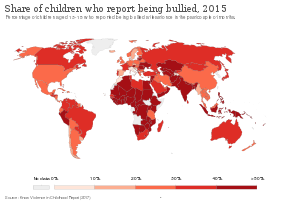| Part of a series on |
| Discrimination |
|---|
 |


Bullying is the use of force, coercion, hurtful teasing, comments, or threats, in order to abuse, aggressively dominate, or intimidate one or more others. The behavior is often repeated and habitual. One essential prerequisite is the perception (by the bully or by others) that an imbalance of physical or social power exists or is currently present. This perceived presence of physical or social imbalance is what distinguishes the behavior from being interpreted or perceived as bullying from instead being interpreted or perceived as conflict.[1][2] Bullying is a subcategory of aggressive behavior characterized by hostile intent, the goal (whether consciously or subconsciously) of addressing or attempting to "fix" the imbalance of power, as well as repetition over a period of time.[3]
Bullying can be performed individually or by a group, typically referred to as mobbing,[4] in which the bully may have one or more followers who are willing to assist the primary bully or who reinforce the bully's behavior by providing positive feedback such as laughing.[5] Bullying in school and in the workplace is also referred to as "peer abuse".[6] Robert W. Fuller has analyzed bullying in the context of rankism.[7] The Swedish-Norwegian researcher Dan Olweus stated that bullying occurs when a person is "exposed, repeatedly and over time, to negative actions on the part of one or more other persons",[8] and that negative actions occur "when a person intentionally inflicts injury or discomfort upon another person, through physical contact, through words or in other ways".[8] Individual bullying is usually characterized by a person using coercive, intimidating, or hurtful words or comments, exerting threatening or intimidating behavior, or using harmful physical force in order to gain power over another person.[9]
A bullying culture can develop in any context in which humans regularly interact with one another. This may include settings such as within a school, family, or the workplace,[10] the home, and within neighborhoods. When bullying occurs in college and university settings, the practice is known as ragging in certain countries, especially those of the Indian subcontinent.[11] The main platform for bullying in contemporary culture involves the use of social media websites.[12][dubious – discuss] In a 2012 study of male adolescent American football players, "the strongest predictor [of bullying] was the perception of whether the most influential male in a player's life would approve of the bullying behavior."[13] A study by The Lancet Child & Adolescent Health medical journal in 2019 showed a relationship between social media use by girls and an increase in their exposure to bullying.[14]
Bullying may be defined in many different ways. In the United Kingdom, there is no legal definition of the term "bullying",[15] while some states in the United States currently have laws specifically against it.[16] Bullying is divided into four basic types of abuse: psychological (sometimes referred to as "emotional" or "relational"), verbal, physical, and cyber (or "electronic"), though an encounter can fall into more than one of these categories.[17]
Behaviors used to assert such domination may include physical assault or coercion, verbal harassment, or the use of threats, and such acts may be directed repeatedly toward particular targets. Rationalizations of such behavior sometimes include differences of social class, race, religion, gender, sexual orientation, appearance, behavior, body language, personality, reputation, lineage, strength, size, or ability.[18][19][20]
- ^ Burger C (2022). "School bullying is not a conflict: The interplay between conflict management styles, bullying victimization and psychological school adjustment". International Journal of Environmental Research and Public Health. 19 (18): 11809. doi:10.3390/ijerph191811809. ISSN 1661-7827. PMC 9517642. PMID 36142079.
- ^ Juvonen, J., Graham, S. (2014). "Bullying in Schools: The Power of Bullies and the Plight of Victims". Annual Review of Psychology. 65: 159–185. doi:10.1146/annurev-psych-010213-115030. PMID 23937767. S2CID 207640520.
- ^ Burger C, Strohmeier D, Spröber N, Bauman S, Rigby K (2015). "How teachers respond to school bullying: An examination of self-reported intervention strategy use, moderator effects, and concurrent use of multiple strategies". Teaching and Teacher Education. 51: 191–202. doi:10.1016/j.tate.2015.07.004.
- ^ Noa Davenport, Ruth Distler Schwartz, Gail Pursell Elliott (1999). Mobbing: Emotional Abuse in the American Workplace. Civil Society Publishing. ISBN 978-0-9671803-0-4. Archived from the original on 2014-01-01. Retrieved 2013-10-28.
- ^ Pouwels JL, Lansu TA, Cillessen AH (2018). "A developmental perspective on popularity and the group process of bullying". Aggression and Violent Behavior. 43: 64–70. doi:10.1016/j.avb.2018.10.003. hdl:2066/196743. ISSN 1359-1789. S2CID 150289090.
- ^ Elizabeth Bennett (2006). Peer Abuse Know More!: Bullying from a Psychological Perspective. Infinity. ISBN 978-0-7414-3265-0. Archived from the original on 14 September 2014. Retrieved 2013-10-29.
- ^ Fuller RW (2017). "Learning to Seek". Learning in a Dignitarian World. Routledge. pp. 29–40. ISBN 978-0-203-78742-7.
- ^ a b "History". OLWEUS Bullying Prevention Program. Archived from the original on 2013-10-29. Retrieved 2013-10-28.
- ^ Valerie E. Besag (1989). Bullies and victims in schools: a guide to understanding and management. Open University Press. ISBN 978-0-335-09542-1. Archived from the original on 2014-07-07. Retrieved 2013-10-29.
- ^ Williams R (3 May 2011). "The Silent Epidemic: Workplace Bullying". Psychology Today. Archived from the original on 2015-11-21. Retrieved 2016-11-13.
- ^ Castleberry CL (2022). The Global Culture of Bullying: Explorations and Recommendations. Taylor & Francis. ISBN 978-1-000-68486-5.
...enacted law to address bullying in colleges and universities, called "ragging."
- ^ Whittaker E (2016). "Cyberbullying via social media". Journal of School Violence: 11–29.
- ^ Steinfeldt JA, Vaughan EL, LaFollette JR, Steinfeldt MC (October 2012). "Bullying among adolescent football players: Role of masculinity and moral atmosphere". Psychology of Men and Masculinity. 13 (4): 340–353. doi:10.1037/a0026645. hdl:2022/14023.
- ^ "Social Media Use May Harm Teens' Mental Health By Disrupting Positive Activities, Study Says". 2019-08-13. Archived from the original on 2021-03-11. Retrieved 2020-12-17.
- ^ "The University of Manchester Dignity at Work and Study Policy". The University of Manchester. January 2012. Archived from the original on 2013-10-29. Retrieved 2013-10-28.
- ^ "State Laws Related to Bullying Among Children and Youth" (PDF). U.S. Department of Health and Human Services – Health Resources and Services Administration – Maternal and Child Health Bureau. Archived from the original (PDF) on March 4, 2011. Retrieved 2013-10-28.
- ^ Brank EM, Hoetger LA, Hazen KP (December 2012). "Bullying". Annual Review of Law and Social Science. 8 (1): 213–230. doi:10.1146/annurev-lawsocsci-102811-173820.
- ^ "Children who are bullying or being bullied". Cambridgeshire County Council: Children and families. Cambridgeshire County Council. 2013-07-24. Archived from the original on 2013-10-29. Retrieved 2013-10-28.
- ^ Ericson N (June 2001). "Addressing the Problem of Juvenile Bullying" (PDF). OJJDP Fact Sheet #FS-200127. 27. Archived (PDF) from the original on 2015-06-26. Retrieved 2013-10-28.
- ^ Meyer D (2016). "The Gentle Neoliberalism of Modern Anti-bullying Texts: Surveillance, Intervention, and Bystanders in Contemporary Bullying Discourse". Sexuality Research and Social Policy. 13 (4): 356–370. doi:10.1007/s13178-016-0238-9. S2CID 148471672.